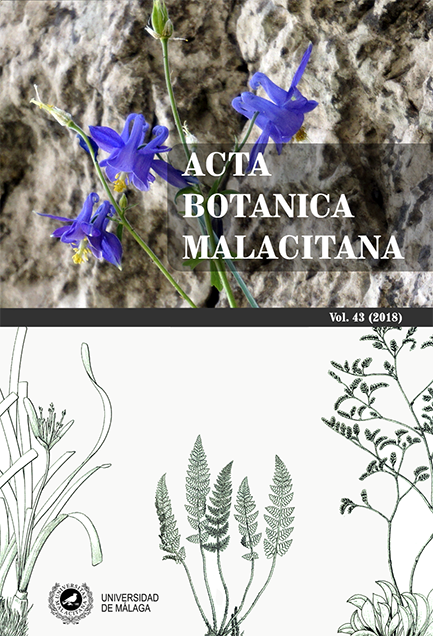Estudio fenológico de angiospermas leñosas mediterráneas del Jardín Botánico de la Universidad de Málaga
DOI:
https://doi.org/10.24310/abm.v43i0.4070Resumen
ResumenSe ha realizado un estudio sobre el comportamiento fenológico de las angiospermas leñosas mediterráneas presentes en el Jardín Botánico de la Universidad de Málaga. Para cada especie se ha elaborado una tabla o calendario anual que incluye fenofases vegetativas y reproductivas. Se analiza y discute la distribución y duración de cada una de las fenofases estudiadas, así como su diversidad en el jardín. Se comparan todos los resultados, tanto de manera particular como general, con los publicados de áreas naturales. También se ha determinado el patrón de comportamiento fenofásico que presenta cada especie, habiendo resultado un total de siete patrones diferentes, la mayoría de tipo superpuesto (con crecimiento vegetativo y floración solapados en su ciclo anual) y minoritariamente de tipo secuencial. Se concluye que el crecimiento vegetativo ocurre fundamentalmente en dos periodos: primavera y otoño- invierno; mientras que la formación de yemas florales así como la floración tiene lugar fundamentalmente durante la primavera, siendo marzo el mes que mayor número de especies la inician. Un porcentaje importante de especies presentan periodos largos (3 ó 4 estaciones del año) de crecimiento vegetativo (30%), floración (22%), fructificación (45%) y dispersión (32%). Se ha comprobado que la mayoría de las especies leñosas mediterráneas cultivadas en el jardín presentan periodos de crecimiento vegetativo y reproducción sexual que coinciden en duración, inicio y final con los publicados en medios naturales de la provincia de Málaga, por lo que los resultados fenológicos que se obtengan de los ejemplares cultivados en el jardín se pueden extrapolar a los que habitan en medios naturales.
Palabras clave: Fenología, angiospermas, fanerófitos, caméfitos, Mediterráneo, jardín botánico.
Abstract
Phenological study of Mediterranean woody angiosperms in the Botanical Garden of the University of Malaga.
A study on the phenological behavior of Mediterranean woody angiosperms present in the Botanical Garden of the University of Malaga has been carried out. For each species an annual table or calendar that includes vegetative and reproductive phenophases has been prepared. The distribution and duration of each phenophases studied, as well as their diversity in the garden, are analyzed and discussed. All results are compared, both in a particular and general way, with those published from natural areas. The phenophasic behavior pattern of each species has also been determined, resulting in a total of seven different patterns, most of which are superimposed (with vegetative growth and flowering overlap in their annual cycle) and a minority of sequential type. It is concluded that the vegetative growth occurs mainly in two periods: spring and autumn- winter, while the formation of floral buds as well as flowering takes place mainly during the spring, with March being the month when the greatest number of species initiate it. A significant percentage of species have long periods (3 or 4 seasons) of vegetative growth (30%), flowering (22%), fruiting (45%) and dispersion (32%). It has been verified that the majority of Mediterranean woody species cultivated in the garden present periods of vegetative growth and sexual reproduction that coincide in duration, beginning and end with those published in natural environments of the province of Malaga. Therefore, the phenological results obtained from specimens grown in garden can be extrapolated to those of natural environments.
Key words: Phenology, angiosperm, woody species, Mediterranean, botanical garden
Descargas
Métricas
Citas
Aljaro, M.E., & Montenegro, G. (1981). Growth of dominant Chilean shrubs in the Andean Cordillera. Mountai Reserach and Development, 1, 287-291.
Azcón, J., & Talón, M. (2008). Fundamentos de Fisiología Vegetal (2ªed.) (pp. 617-638). Madrid: McGraw-Hill Interamericana.
Blanca, G., Cabezudo, B., Cueto, M., Morales, C., & Salazar, C. (2011). Flora Vascular de Andalucía Oriental. Granada: Universidades de Granada, Almería, Jaén y Málaga.
Cabezudo, B., Navarro, T., Pérez Latorre, A.V., Nieto, J.M., & Orshan, G. (1992). Estudios fenomorfológicos en la vegetación del sur de España. I. Cistus L. Acta Botanica Malacitana, 17, 229-237.
Castroviejo, S. (Coord.). (1986). Flora Ibérica. Plantas Vasculares de la Península Ibérica e Islas Baleares. Madrid: Real Jardín Botánico, CSIC.
Floret, CH., Galán, M.J., Le Floc´h, E., Leprince, F., & Romane, F. 1989. Description on plant annual cycles. France. In G. Orshan (Ed.), Plant pheno-morphological studies in Mediterranean type ecosistems (pp. 9-97). Dordrecht: Klumer Academic Publishers.
Hidalgo, M.I., & Cabezudo, B. (1994). Fenología y volumen de floración del matorral de la Sierra de Mijas (Málaga, S. España). Acta Botanica Malacitana, 19, 123-136.
Hidalgo-Triana, N., Pérez Latorre, A.V. & Hanse Thorne, J. (2017). Plant functional traits and groups in a Californian serpentine chaparral. Ecological Research, DOI 10.1007/s11284-017-1532-6.
Hoffmann, A.J. (1972). Morphology and histology of Trevoa trinervis (Rhamnaceae) a drought-deciduous shrub from the Chilean matorral. Flora,16, 527-538.
Hoffmann, A.J. 1981. Seasonal growth rhythm in Peumus boldus a deciduous tree of the Chilean mediterranean vegetation. Ecology of Plant, 2: 31-39.
Hoffmann, A.J., & Hoffmann, A.E. (1976). Growth patterns and seasonal behaviour of the buds os Colliguaya odorifera, a shrub from the Chilean mediterranean vegetation. Canadian Journal of Botany, 54, 1774-1787.
Hoffmann, A.J., & Walker, M.J. (1980). Growth habits and phenology of drought- decidous species in an altitudinal gradient. Canadian Journal of Botany, 58, 1789-1796.
Le Roux, A. , Perry, P., & Kyriacou, X. (1989). Description on plant annual cycles. South Africa. In G. Orshan (Ed.), Plant pheno-morphological studies in Mediterranean type ecosistems (pp. 159-346). Dordrecht: Klumer Academic Publishers.
Médali, F. & Quétzel, P. (1999). Biodiversity Hotspots in Mediterranean Basin: Setting Global Conservation Priorities. Conservation Biology, 13, 1510-1513.
Montenegro, G., Aljaro, M.E., & Kummerow, J. (1979). Growth dynamics of Chilean matorral shrubs. Botanical Gazette, 140, 114-119.
Montenegro, G., Avila, G., Aljaro, M.E., Osorio, R., & Gomez, M. (1989). Description on plant annual cycles. Chile. In G. Orshan (Ed), Plant pheno-morphological studies in Mediterranean type ecosistems (pp. 347-387). Dordrecht: Klumer Academic Publishers.
Montenegro, G. (1987). Quantification of mediterranean plant phenology and growth. In: Tenhunen, J.D., Catarino, F.M., Lange, O.L., Oechel, W.C. (eds.) Planta Response to Stress. NATO ASI Series, Series G Ecological Sciencies, vol. 15. Berlin: Springer.
Navarro, T. & Cabezudo, B. (1998). Estrategias fenomorfológicas en especies de un matorral mediterráneo (Andalucía, España). Acta Botanica Malacitana, 23, 133-148.
Navarro, T., Pascual, V. Cabezudo, B. & Alados, C. (2009). Architecture and functional traits of semi-arid shrub species in Cabo de Gata Natural Park, SE Spain. Candollea, 64, 69-84.
Orshan, G. (1964). Seasonal dimorphism of desert and mediterranean chamaephytes and their significance as a factor in their water economy. In A.J. Rutter & F.H. Whiehead (Eds.), Water in relation to plants (pp. 206-222). Oxford: Blackwell.
Orshan, G. (1982). Monocharacter growth-form types as a tool in an analytic-synthetic study of growth-forms in Mediterranen type ecosistems. A proposal for an inter-regional program. In Ecologia mediterranea. Définition et localisation des écosystèmes méditerranéens terrestres. Saint-Maximin 16-20 November 1981 (pp. 159-171).
Orshan, G. (1986). Plant form as describing vegetation and expressing adaptation to environment. Annals of Botany, 44, 7-38.
Orshan, G. (1989). Plant pheno-morphological studies in Mediterranean type ecosistems. Dordrecht : Klumer Academic Publishers.
Palacio, S. & Montserrat-Martí, G. (2006). Comparison of the bud morphology and shoot growth dynamics of four species of Mediterranean subshrub growing along an actitudinal gradient. Botanical Journal of Linnean Society, 151, 527-539.
Pérez, A.V., Cabezudo, B., Nieto, J.M., & Navarro, T. (1996). Caracterización fenológica y ecomorfológica de alcornocales andaluces (Málaga, España). Anales del Jardín Botánico de Madrid, 54, 554-560.
Pérez, A.V., & Cabezudo, B. (2002). Use of monocharacteristic growth forms and phenological phases to describe and differentiate plant communities in Mediterranean-type ecosystems. Plant Ecology, 161, 231-249.
Pérez-Latorre, A.V., & Cabezudo, B. (2006). Phenomorphological and eco-morphological characters of Rhododendron lauroid forest in the Western Mediterranean (Iberian Peninsula, Spain). Plat Ecology, 187, 227-247.
Pérez-Latorre, A.V., Gavira, O., & Cabezudo, B. (2010). Phenomorphology and ecomorphological caracteres of Maytenus senegalensis L. shrublands in the Iberian Peninsula: A comparison with other Mediterranean plant communities. Flora, 205, 200-210.
Pérez-Latorre, A.V., Gavira, O., & Cabezudo, B. (2010). Ecomorphology and phenomorphologyof Mediterranean heathlands (SW Iberian Peninsula). Phytocoenologia, 37, 239-268.
Recio, M. (Coord.). (2012). Plantas del Jardín Botánico de la Universidad de Málaga. Gimnospermas. Málaga: Servicio de Publicaciones de la Universidad de Málaga.
Rutherford, M.C., & Panagos, M.D, (1982). Seasonal woody plant shoot growth in Burkea africana - Ochna pulchra savanna. South African Journal of Botany, 1, 104-116.
Spano, D., Cesaraccio, C., Dulce, P., & Snyder, R.L. (1999). Phenological stages of natural species and their use as climate indicators. International Journal of Biometeorology, 42, 124-133.
Stebbins, G.L. (1974). Flowering Plants. Evolution above the Species Level. London: Harvard University Press.
The Angiosperm Phylogeny Group. (2009). An update of the Angiosperm Phylogeny Group classification for the orders and families of flowering plants: APG III. Botanical Journal of the Linnean Society,161, 105–121.
Valdés, B., Talavera, S., & Galiano, E. (1987). Flora Vascular de Andalucía Occidental. Barcelona: Ketres.
Westman, W.E. (1981). Seasonal dimorphism of foliage in Californian Coastal sage scrub. Oecologia, 51, 385-388.
Descargas
Publicado
Cómo citar
Número
Sección
Licencia
Derechos de autor 2018 Acta Botanica Malacitana

Esta obra está bajo una licencia internacional Creative Commons Atribución-NoComercial-CompartirIgual 4.0.
Toda la información relacionada con la licencia de uso de los trabajos publicados en Acta Botanica Malacitana y con los derechos de autor se pueden consultar en nuestra Política Editorial.








1.png)


